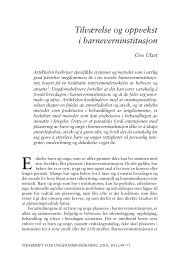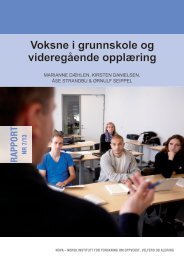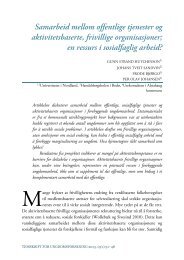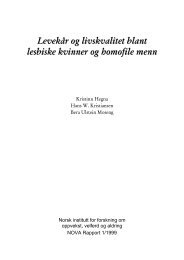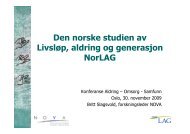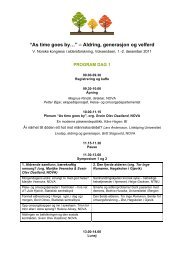Parents' socioeconomic status and children's academic ... - Nova
Parents' socioeconomic status and children's academic ... - Nova
Parents' socioeconomic status and children's academic ... - Nova
You also want an ePaper? Increase the reach of your titles
YUMPU automatically turns print PDFs into web optimized ePapers that Google loves.
project: an immigrant is a person whose parents are born abroad, regardless<br />
of where that person is born. Most immigrant children in this project were<br />
born in Norway.<br />
3.2 Data analysis<br />
Our analysis is based on both bivariate <strong>and</strong> multivariate methods. In the<br />
bivariate analysis, cross tabulation with the ordinal measure of association,<br />
gamma ‘γ’, is used to test the association between two variables. For comparisons<br />
between scores across different groups, we use a traditional<br />
binominal population proportion test. Multivariate analysis is conducted by<br />
linear regression, with the sum of the marks in each of the three subjects as<br />
the response variable.<br />
Gamma is an ordinal measure of association between two ordinal<br />
variables. It utilises the concepts of concordant <strong>and</strong> discordant pairs of<br />
observations. Although gamma is both a powerful <strong>and</strong> intuitive interpretable<br />
statistic, it is not frequently used. We therefore give a brief explanation of the<br />
concepts of concordant <strong>and</strong> discordant pairs <strong>and</strong> the gamma measure (for a<br />
more complete <strong>and</strong> somewhat more formal description, see Agresti <strong>and</strong><br />
Finlay 2009). In our description here we use pupils’ grades <strong>and</strong> parents’<br />
education as an example. From a sample with n observations, n*(n-1)/2 pairs<br />
can be drawn. A concordant pair is a pair of observations where the observation<br />
with the (strictly) highest score on parental education also has the<br />
(strictly) highest score on children’s school results. A discordant pair is a pair<br />
of observations where the observation with the (strictly) highest value on<br />
parental education has the (strictly) lowest value on children’s school<br />
achievements. 3<br />
The gamma measure is based on a count of concordant <strong>and</strong> discordant<br />
pairs of observations. It is the st<strong>and</strong>ardized difference between the total<br />
number of concordant pairs (positively associated pairs) <strong>and</strong> the total<br />
number of discordant pairs (negatively associated pairs) in the resulting<br />
contingency table of two variables. In other words, gamma is the difference<br />
3<br />
A pair that is neither concordant nor discordant is termed a tie. The incidence of ties<br />
is not utilised in the calculation of the gamma-statistic.<br />
– Parents’ <strong>socioeconomic</strong> <strong>status</strong> <strong>and</strong> children’s <strong>academic</strong> performance – 21





